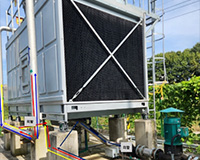DISASTER SAFETY AI SOLUTION
Distributed optical sensors (optical cables for communications) are installed in measurement sections to continuously measure strain, acoustic
vibrations, temperature, and other parameters. These collected data are analyzed and monitored in real time to detect any anomalies.

e-DSS uses an optical fiber cable as sensors to measure the distribution forms of physical quantities (vibrations, acoustic vibrations, temperature, etc.) across the entire sections of the optical cable (sensor). Based on its generated optical signals, the system receives and analyzes backscattered light signals generated by the optical cable (sensor) to measure physical quantities at different points along the cable.

By measuring the physical quantities of temperature changes over long distances and continuous or specific sections, this system overcomes the limitations of traditional monitoring systems. It helps to detect fires and prevent safety accidents by detecting temperature changes in real time across various facilities and structures.
Sensor
Optical cable
Data trend
measurement
Optical measurement
system(e-DSS)
Classification of measured data
Edge AI analysis
Real-Time status detection
Monitoring
[System Configuration Diagram]
Measurement of position information and physical quantity changes by performing Fourier transforms on the scattered signals in the optical fiber in response to frequency variations of the light source
Detection and precise safety diagnosis of anomalies such as cracks, bending, and deformation over the extensive areas in industrial facilities
Offering of the data about strain distribution, impact position and size, and damage occurrence points.
Precise safety diagnosis through high strain resolution
Cost saving for initial setup by using an existing optical fiber cable for communications as a sensor
(changeable according to on-site conditions)
Zero impacts of communication restrictions, dust, and humidity due to immunity to EMI(electromagnetic interference)
| Maximum Measurement Distance | 100m |
|---|---|
| Strain Resolution | 5με |
| Number of Channels | 1ch |
| Data Update Time | 10sec |
| Position Resolution | 10mm |
|---|---|
| Strain Measurement Range | ±3,000 με |
| Temperature Correction Accuracy | ±2℃ |
| - | - |
| Optical Cable Terminal | FC/APC |
|---|---|
| Ethernet | - |
| USB | - |
| Display | - |
| - | - |
| Product Size | 435x535x129mm |
|---|---|
| Weight | 7.39Kg |
| Operating Temperature | -10 ~ 40℃ |
| Operating Humidity | 10 ~ 90%, Non-condensing |
| Storage Temperature | -40 ~ 80℃ |
| Laser Safety Class | Class 1 |
|---|---|
| Product Certification | KC, FCC |
| - | - |
| Operating Voltage | 100 ~ 230 VAC |
|---|---|
| Operating Voltage Frequency | 50 ~ 60 Hz |
| Power Consumption | -W (typical) |
| Rack | 19" Rack 42U |
|---|---|
| DAQ Unit | DAS signal data collection, analysis, and processing |
| Storage | DAS signal data storage |
| DAS signal data deep-learning analysis | Analysis Server |
| Visualization Server | Visualization of DAS analysis information |
|---|---|
| UPS | Uninterruptible Power Supply |
| L2 Switch | L2 Network Switch |
| KVM | KVM for Server |
* The system configuration may vary depending on the purpose and environment.

Power
Generation
Equipment

Bridges

Railway Tracks

Concrete
Structures